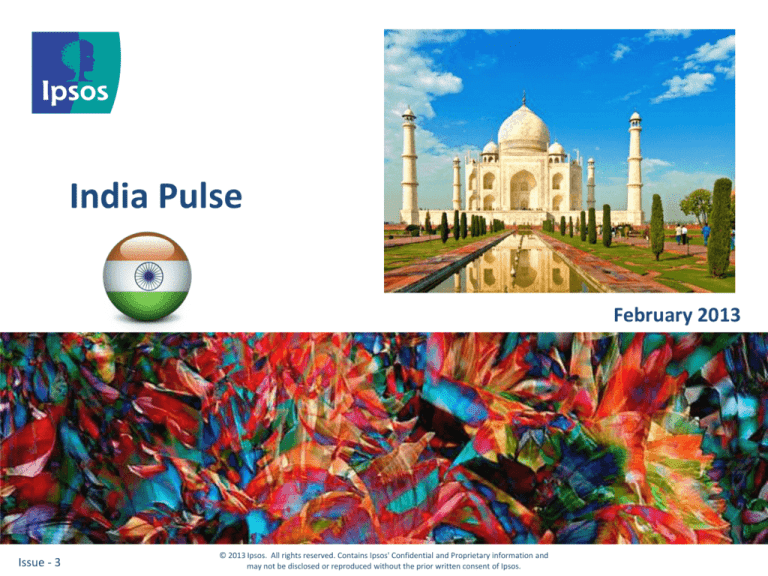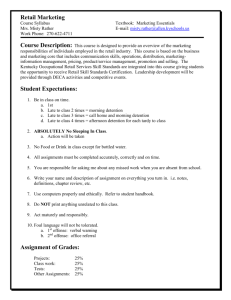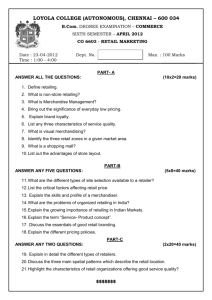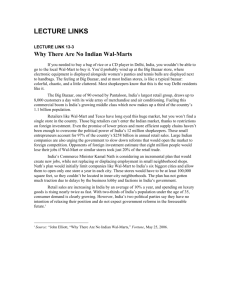
India Pulse
February 2013
Issue - 3
© 2013 Ipsos. All rights reserved. Contains Ipsos' Confidential and Proprietary information and
may not be disclosed or reproduced without the prior written consent of Ipsos.
Content
1. Indian Economy
2. Indian Retail Industry
3. Major Players in Indian Retail Industry
4. New Big Players in Indian Retail Industry
2
Indian Economy
Macroeconomic Snapshot
• India is the Second Most Economically Confident Country in the world in January 2013 – Ipsos
Economic Pulse of the World Survey
• In India inflation has been showing signs of abating in the last few months, January inflation
was lowest in 4 months at 6.62 per cent
• Shedding its 9-month long hawkish monetary policy stance, the Reserve Bank of India slashed
its key interest rates by 0.25 per cent taking cognisance of the moderation in demand side
pressures to inflation and greater than anticipated slowdown in growth
• Easing of policy rates will bring in additional liquidity into the system to perk up growth
through reduced cost of borrowing
• The year 2013 is likely to see revival in the industrial activity and modest recovery in the
services sector which would support recovery in growth levels
3
Indian Economy
Macroeconomic Snapshot
• For financial year 2012-13 the government’s
projection for growth is 5.7 - 5.9 per cent
• Moody’s says India’s sovereign rating outlook
“stable”. Expects India’s GDP to grow at 6 per cent
in 2013-14
• India targets 8 per cent average growth rate over a
period of five years ( 2012-17)
• India’s Foreign exchange reserves increased by US$
39.6 million to touch US$ 296.57 billion for the
week ended December 28, 2012
• Government moving towards a direct subsidy
transfer mechanism to cut expenditure and directly
reach the poor
• FII Inflows for 2012 were at US$ 22 billion, the
second highest since 1993
• Indian stocks are the top selection among BRIC
nations in 2013 for JP Morgan Chase & Co.
4
Indian Economy
Macroeconomic Snapshot
• The exchange rate has remained more or less stable from August to December 2012
• The HSBC Markit India Manufacturing PMI for December 2012 rose to 54.7 from 53.7 in
November 2012. This was the highest rise in six months
• India’s exports have fluctuated, but maintained a more-or-less steady level. Indian exporters
have looked at new markets in Asia and Africa to overcome the slowdown in traditional
markets
• Government has provided sops to boost exports like bringing more markets for benefits
under the focus market scheme
5
Indian Economy
Growth Enablers: Policy Thrust
Parliament Moves Reforms Forward
The Winter Session of Indian Parliament has passed 17 pieces of legislation. Critical decisions
include:
• Nod for FDI in multi brand retail
• Passage of Banking Laws (Amendment) Bill 2011 which permits voting rights in
proportion to shareholding and strengthens the supervisory and regulatory powers of the
Reserve Bank of India
• The Prevention of Money-Laundering (Amendment) Bill, 2011, passed. Links Indian laws
to laws in other countries and enlarges the definition of money-laundering and removes
the existing limit on fines for money laundering
• Lok Sabha passes Companies Bill, 2011 paving the way for a new company law
• Besides making independent directors more accountable and improving corporate
governance practices, the Bill seeks to make corporate social responsibility mandatory for
certain companies
• The Bill will have to be passed by the
Rajya Sabha (The Upper House) before it
becomes a law
6
Indian Economy
Growth Enablers: Policy Thrust
Government Moves on Reforms
• Cabinet Committee on Investment set up to fast-track infrastructure projects worth over
Rs 1,000 crore
• Prime Minister to Chair Committee of Ministers of all infrastructure-related ministries to
give timelines for projects. This will help speed up over 90 projects
• Union Cabinet clears Land Acquisition Bill, which provides for higher compensation while
removing the clause requiring consent of land losers for government projects. For private
projects 80 per cent of land losers need to provide a consent, while for public-privatepartnership projects, the consent of 70 per cent land losers will be required
Securities & Exchange Board of India (SEBI) Tightens
Norms
• Strict oversight mechanism for brokers and other
market intermediaries mooted to cover risks posed by
their business activities on investors & market
• Stops mini futures and options based on indices to
protect small investors
• Looks to boost corporate bond market to bring liquidity
in the secondary market
7
Indian Economy
Growth Enablers: Policy Thrust
External Commercial Borrowings (ECB) Norms
• The Reserve Bank of India (RBI) has relaxed ECB norms for infrastructure finance
companies, allowing them to avail overseas borrowings up to 75 per cent of their net
worth without its approval, an increase from 50 per cent earlier
• Also reduced the hedging requirement for currency risk from 100 per cent of their
exposure to 75 per cent
• In the first nine months of 2012, Indian firms raised around $ 28 billion via ECBs. They
raised around $ 1.34 billion through ECB and foreign currency convertible bonds (FCCB) in
November 2012 alone to fund modernisation, foreign acquisitions, imports of capital
goods and onward lending
Government bats for tough reforms
• Raises rail fares marginally to bridge deficit
• Starts direct cash transfers to benefit poor families
in 20 districts for seven government sponsored
schemes
• Seeks phased reduction of energy subsidies
• Working on early implementation of goods and
service tax
8
Indian Economy
Growth Enablers: Policy Thrust
Science Policy Unveiled
• Prime Minister Dr. Manmohan Singh launches Science, Technology and Innovation Policy
(STI) 2013 with emphasis on innovation, setting up research institutes and encouraging
women scientists with an aspiration to place India among the top five scientific powers in
the world by 2020
• The government endeavours to create a policy environment for enhanced private sector
collaboration in research and innovation and to form international alliances
• Policy targets increase in gross expenditure in R&D to 2 per cent of Gross Domestic
Product from the current 1 per cent in this decade by supporting increased private sector
participation
9
Indian Retail Industry
10
Indian Retail Industry
India`s retail sector on growth path
The Indian retail industry has grown at a Compounded Annual Growth Rate (CAGR) of 13.3
percent for the period FY06-10. The growth in the Indian economy since the last decade and the
change in consumption pattern of the Indian populace in terms of higher proportion of middle
class population, greater proportion of working women, etc. can unarguably be linked to the
growth of the Indian retailing industry.
Of all the segments in retail, the contribution of ‘food & grocery’ remained the highest at 58
percent of the total retail sales during FY10, with the ‘clothing & footwear’ segment remaining the
second largest contributor occupying 10 percent of the total retail pie during the same period.
However in terms of growth figures, the ‘entertainment, books & sports goods equipment`
segment outperformed the other retail segments registering a CAGR of 22.5 percent during the
period FY06-10.
The country's traditional retail industry is expected to grow at an average annual rate of five
percent over the next year, while the organised retail is estimated to register a growth rate of
around 25 percent during this period.
11
Indian Retail Industry
Estimated Figure of Indian Retail Industry
The retail sector in the nation of 1.2 billion people is estimated to have had annual sales of $450
billion in 2011, with nearly 90 percent of the market controlled by tiny family-run shops.
The Indian retail market is estimated to be US$ 480 billion by 2014, accounting for 33-35% of
GDP and is expected to grow to US$ 650 billion by 2016.
Modern retail, which currently stands at 5 percent, will grow about six times from the current
$27 billion to $220 billion in the next 8 years. Integrated multi-channel retailing will drive
consumption in India.
Modern retailers have in the past tried to capitalise on this opportunity by increasing their store
presence across major cities. Fast moving consumer goods (FMCG) majors, have on the other
hand, have tried to enhance distribution reach.
For long, the analysts have been betting on strong retail and
financial services sector performances to help and power India –
Asia’s third-largest economy. Such expectations further get a boost
as more and more Indians move towards western-style consumer
spending patterns.
While Fitch, the global ratings agency, has recently opined that
Indian consumer spending is at its weakest in seven years, FICCI,
believe that India’s retail sector will become a USD 1.3 trillion
opportunity by 2020. By that time, there will be close to 200 cities
with population of over 0.5 million that will fuel retail growth.
12
Indian Retail Industry
Organised retail, or large chains, makes up about 5 percent of the market, but is expanding at
25 percent a year. This is driven by the emergence of shopping centres and malls, and a middle
class of close to 300 million people that is growing at nearly 2 percent a year.
The organized retail market is estimated at US$ 26 billion and accounts for ~6% of the overall
retail market as of 2011. The organized retail market is projected to grow to US$ 88 Billion by
2016.
Over 350 million shoppers are likely to buy from organized retail by 2016.
With an estimated market of US$ 320 B the food & grocery segment is the single largest retail
category and accounts for 70% of the total retail market currently. The organized retail
segment for Food & Grocery is estimated at US$ 8.5 B and accounts for 35% of all organized
retail.
Currently, almost 95 percent of India's retail industry
is unorganised or traditional.
India also allows 100 percent FDI in cash-and-carry, or
wholesale, ventures. Restrictions on foreign
investment in front-end retail existed because of
opposition from millions of small shopkeepers who
are valuable vote banks during elections.
India has recently allowed 100 percent FDI in singlebrand retail subject to certain sourcing restrictions but
no ownership in multi-brand retail.
13
Indian Retail Industry
Look Beyond the Conventional Brick-and-Mortar Stores
However, achieving these robust growth projections requires the industry to look beyond the
conventional brick-and-mortar stores, and consider other avenues like digital and mobile sales.
This is because expensive real estate costs are already playing spoilsport for retailers.
Real estate costs, especially, high rentals that are in range of 10 – 15% of revenue, render
breaking even a daunting task. Retailers need to rethink their business plans and shift a chunk
of their sales from stores to alternate low-cost channels.
Digital sales points are increasingly becoming a preferred option for retailers. Sales through
digital channels, notably websites and mobile applications, which at present are miniscule, will
increase to 6-8 % of the total modern retail, by amounting to about USD 13.3-17.6 Billion by
2020.
Time has also come for a more robust and
symbiotic relationship between retailers and
FMCG companies. FMCG firms have a lot to
gain with the advent of multi-channel retailing.
However, the depth of retail FMCG
collaboration will be one of the key success
factors for multi-channel retailing. It is
imperative for retailers and FMCG majors to
collaborate for assortment planning,
replenishment, space planning and promotion
as they have a lot to gain.
14
Indian Retail Industry
FDI in Retail
Government of India recently took a decision to allow up to 51 percent FDI in multi-brand retail and
raise the limit for overseas investment in single-brand retail to 100 percent.
FICCI said an estimated investment of almost Rs. 64,000 core is required to build a strong back-end
infrastructure in the country. FDI in retail would help in addressing this issue with compulsory
investment of 50 percent in back-end.
Lack of adequate storage facilities cause huge wastage of food products. According to some industry
estimates, 35-40 percent of fruits and vegetables and nearly 10 percent of food grains in India are
wasted annually due to lack of storage facilities.
Booz & Co, said nearly 800,000 people were currently employed directly in organised retail in India.
Without FDI this number is expected to increase to two million by 2016 (another four million
opportunities via indirect employment). However, FDI in retail can potentially add another 1.5 million
jobs by 2016 where additional direct employment will rise by 0.5 million and additional indirect
employment will increase by one million.
Less than 80 percent of this employment
opportunity will be for people with minimum
qualifications. These jobs will offer higher salaries,
defined career paths and better work environment
compared to unorganised retail.
Even as the Union cabinet permitted 51 per cent
FDI in multi-brand retail in September, no
international chain is yet to announce India plans or
make an application to the Foreign Investment
Promotion Board.
15
Major Players in Indian
Retail Industry
16
Major Players in Indian Retail Industry
Pantaloon Retail
Pantaloon Retail, India's largest listed retailer and part of
the Future Group. The flagship company of Future Group,
Pantaloons Retail operates over 16.5 million square feet of
retail space, has over 1300 stores across 73 cities in India
and employs over 30,000 people. It can boast of launching
the first hypermarket Big Bazaar in India in 2001.
The companies also operates in other retail segments such
as - Food & grocery (Big bazaar, Food bazaar), Home
solutions (Hometown, furniture bazaar, collection-i),
Consumer electronics (e-zone), shoes (shoe factory), Books: music & gifts (Depot), Health & Beauty
care services (Star, Sitara and Health village in the pipeline), e-tailing (Futurbazaar.com),
entertainment (Bowling co.) The turnover this year was 12500 crores.
Future has for long been linked to France's Carrefour for a partnership in hypermarkets. It is recently
sold controlling stake in its flagship clothing brand Pantaloon to bring down its high debt.
17
Major Players in Indian Retail Industry
Reliance
Second-ranked Reliance Retail is part of Reliance Industries, India's largest listed group headed
by Mukesh Ambani, India's richest man. Reliance Retail operates 1,300 stores across
neighbourhood stores, supermarkets, hypermarkets and lifestyle stores. It has said it doesn't
plan to partner with any global retailer.
The company further plans to launch its hypermart in Delhi / NCR, Hyderabad, Vijaywada, Pune
and Ludhiana region. The turnover was 4500 crore for this year.
Major Players in Indian Retail Industry
K Raheja Group
They forayed into retail with Shopper’s Stop, India’s first
departmental store in 2001. It is the only retailer from
India to become a member of the prestigious
Intercontinental Group of Departmental Stores (IGDS).
They have signed a 50:50 joint venture with the Nuance
Group for Airport Retailing. Shoppers Stop, part of the K
Raheja Group which operates in real estate, has about
265 stores across brands and formats including 12
Hypercity hypermarkets. It operates 4.58 million square
feet of retail space and its loss-making Hypercity is open
to partnerships with foreign groups.
It has also introduced new formats in the market viz
HomeStop – the exclusive home furnishings, décor as well as
furniture store and HyperCity– a premium shopping
destination for Foods, Homeware, Home Entertainment, HiTech Appliances, Furniture, Sports, Toys & Fashion. Other
format of the company includes -- Crossword Book Store,
Mothercare & Early Learning Centre (ELC), Estee Lauder
group , Airport Retailing, TimeZone Entertainment. The
turnover this year was 1570 crores.
19
Major Players in Indian Retail Industry
Tata
Established in 1998, Trent - one of the subsidiaries
of Tata Group - operates 106 stores across formats
and runs the Westside, a lifestyle retail chain and
Star Bazaar - a hypermarket with a large assortment
of products at the lowest prices. In 2005, it acquired
Landmark, India`s largest book and music retailer.
Tata’s has also formed a subsidiary named Infiniti
retail which consists of Croma, a consumer
electronics chain. Another subsidiary, Titan
Industries, owns brands like “Titan”, the watch of
India and Tanishq, the jewellery brand. Sales
turover was 197.13 crore in December 2010.
It signed a franchisee agreement with Tesco Plc. under which Star Bazaar shops use the British
firm's supply chains and infrastructure. Tesco, Britain's largest retailer is also looking to enter
the wholesale market through the tie-up.
Major Players in Indian Retail Industry
Aditya Birla Group
Aditya Birla Retail is the unlisted retail arm of India's
telecoms-to-cement conglomerate Aditya Birla Group,
headed by Kumar Mangalam Birla, ranked the seventhrichest Indian by Forbes in March 2012.
Aditya Birla Group`s brand portfolio includes brands such as
Louis Phillipe, Van Heusen, Allen Solly, Peter England, Trouser
town. Also, Madura garments is subsidiary of Aditya Birla
Nuvo Ltd. The recently acquired food and grocery chain of
south, Trineth, has further increased their number of store to
400 stores in the country. The company also own ‘More’
supermarkets and hypermarkets. Currently it runs 600
supermarket and nine hypermarkets across India. The
turnover this year was 1700 crores.
It has said it will evaluate partnerships with global firms.
Major Players in Indian Retail Industry
RPG
One of the first entrants into organised food & grocery retail with FoodWorld stores in 1996
and then formed an alliance with Dairy Farm International and launched Health & Glow
(pharmacy & beauty care) outlets.
Now the alliance has dissolved and RPG has Spencer’s Hyper, Super, Daily and Express
formats and Music World stores across the country.
Major Players in Indian Retail Industry
Landmark Group
Landmark Group was launched in 1998 in India; currently owning 100 stores across various
retail formats. The retail ventures of Landmark Group includes - Home Centre, Centrepoint,
Babyshop, Splash, Shoe Mart, Lifestyle, Max, Lifestyle Department Stores, SPAR hypermarkets,
Foodmark, Fun City, Fitness First, Citymax India, etc. It is a 3.8 billion dollar company.
Major Players in Indian Retail Industry
Vivek Ltd.
Vivek Limited is the largest consumer electronics and home appliances retail chain in India,
with 44 stores in south, covering a retail space area of over 1, 75, 000 sq. ft. and a turnover of
over Rs. 400 crore.
Its brand, Viveks, is now a household name. The company plans to set up 50 more showrooms
in South India.
24
New Big Players in
Indian Retail Industry
25
New Big Players in Indian Retail Industry
Bharti-Walmart
Walmart, in a 50-50 joint venture with Bharti Enterprises, had set up its first cash and carry store
in India in 2009 and now has a total of 20 stores called “Best Price Modern Wholesale”. Wal-Mart
will be taking care of cash & carry business and Bharti will do the front-end retailing. Further they
plan to invest USD 7 billion in creating retail network in the country including 100 hypermarkets
and several hundred small stores.
Bharti Enterprises, (the parent of leading mobile provider Bharti Airtel), plans to add 12-15 new
cash-and-carry stores every year.
New Big Players in Indian Retail Industry
METRO
Germany's METRO Cash & Carry opened its first wholesale centre in the country in 2003 at
Bangalore. With this, METRO introduced the concept of Cash & Carry in India. Since then METRO
has opened one more centre in Bangalore, two in Hyderabad, two in Mumbai and one each in
Kolkata, Ludhiana, Delhi, Jaipur, Vijayawada, Amritsar, Zirakpur, Jalandhar & Indore . These
centres offer the benefit of quality products at the best wholesale prices.
METRO offers assortment of over 18000 articles across food and non-food at the best wholesale
prices. The company plans to open 5 cash-and-carry stores every year.
New Big Players in Indian Retail Industry
Carrefour
The euro 81-billion French retail group Carrefour has 4 cash-and-carry stores in India. The
world's No. 2 retailer has been seeking a local partner to enter the hyper or supermarket
sectors.
Carrefour has recently opened a store in Agra , it has stores in Delhi, Jaipur, Meerut. It
had launched its first India store in New Delhi in December 2010, followed by Jaipur
around 2011-end.
Source
National Sample Survey Organisation
ADPCORE
IBEF
Reserve Bank of India (RBI)
Ministry of Finance
CEIC
IMF
UN Stats
World Economic Forum
World Bank
EIU
HSBC
Ministry of Commerce
CRISIL
Hover Data Analytics
SEBI
The Economic Times
DIPP
Morgan Stanley
JP Morgan Chase & Co
Money Control
CEBC
Financial Times
CSO
Yahoo Finance
FICCI
Fitch
Biswarup Banerjee
biswarup.banerjee@ipsos.com
Client’s logo + 91 22 66208000
www.ipsos.com
30







